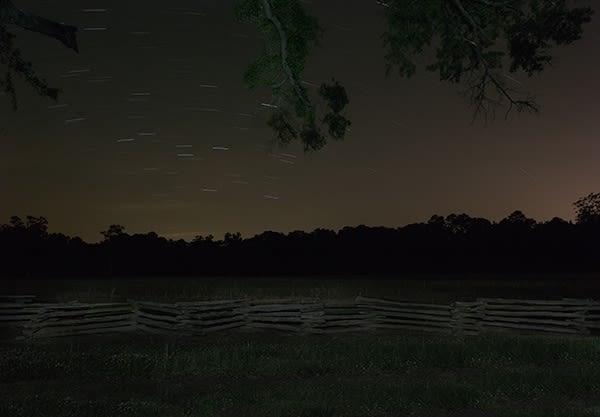The Underground Railroad comprised a group of committed individuals who worked against prevailing political beliefs to resist slavery. With the divide between our political parties deepening every day, the story of the Underground Railroad continues to serve as an example of America at its best. Last year’s bestselling novel by Colson Whitehead, The Underground Railroad, and the opening of the Harriet Tubman Underground Railroad Visitor Center in Maryland provide context for this traveling exhibition by Jeanine Michna-Bales.
The 19th-century clandestine network of abolitionists helped an estimated 100,000 slaves escape to the northern United States and Canada between 1830 and the end of the Civil War in 1865. They would travel 20 miles a night, following the stars, oral instructions, and signals along the way. This is the narrative that accompanies Michna-Bales’s series of nocturnal photographs. For this series, on view at Arnika Dawkins Gallery through March 31, the Dallas-based artist determined a 1,300-mile route from Louisiana to Canada that slaves might have followed on their flight to freedom, and over two years, traveled that route to photograph known safehouses and locations where fleeing slaves found shelter.
The scenes include actual sites – fields, woods, country houses, and back roads – that fugitive slaves passed through or hid in during the day as they worked their way north. Michna-Bales scoped out the locations during the day and returned in the dead of night to photograph the scenes. On particularly dark nights, she would sometimes “paint” the scene with a flashlight during the long exposure.

Jeanine Michna-Bales, Tracking the Deer, Skirting the Osburn Stand, Mississippi, 2014. Courtesy Arnika Dawkins Gallery
Her goal was to present the sites as they might’ve appeared to the slaves as they traveled at night, to evoke a sense of risk, fear, and uncertainty. In a haunting photo of a Mississippi swamp, you can almost hear the buzz of insects and the gentle, unavoidable splashing of water. A photo of a distant house with illuminated windows seems welcoming, though the artist says fugitive slaves might have approached apprehensively.
During a gallery talk, the artist, who is white, addressed the issue of her race and perceived ownership of narrative. She explained that, while the Underground Railroad is embedded in the African-American experience, it is a shared American history.
The final images of the journey were taken in Canada and depict sunrises – to symbolize the former slaves’ hard-won freedom and new beginnings. While these images may give the suite a perhaps too easy denouement – and while it wasn’t a happy ending for slaves who were caught – they offer a palpable sense of the relief and uplift that many slaves must have experienced at the end of the arduous journey.


